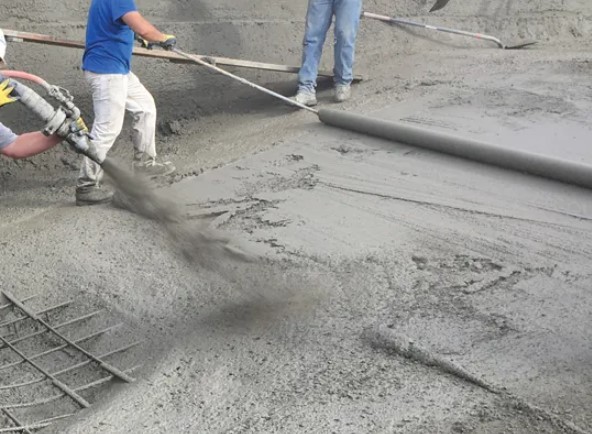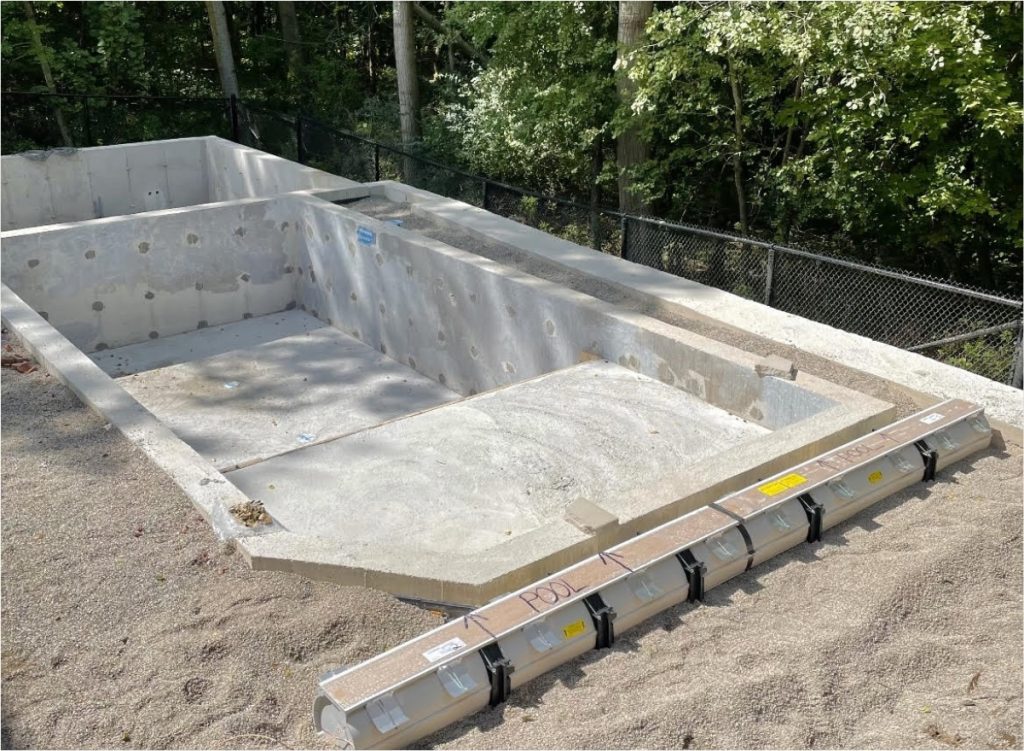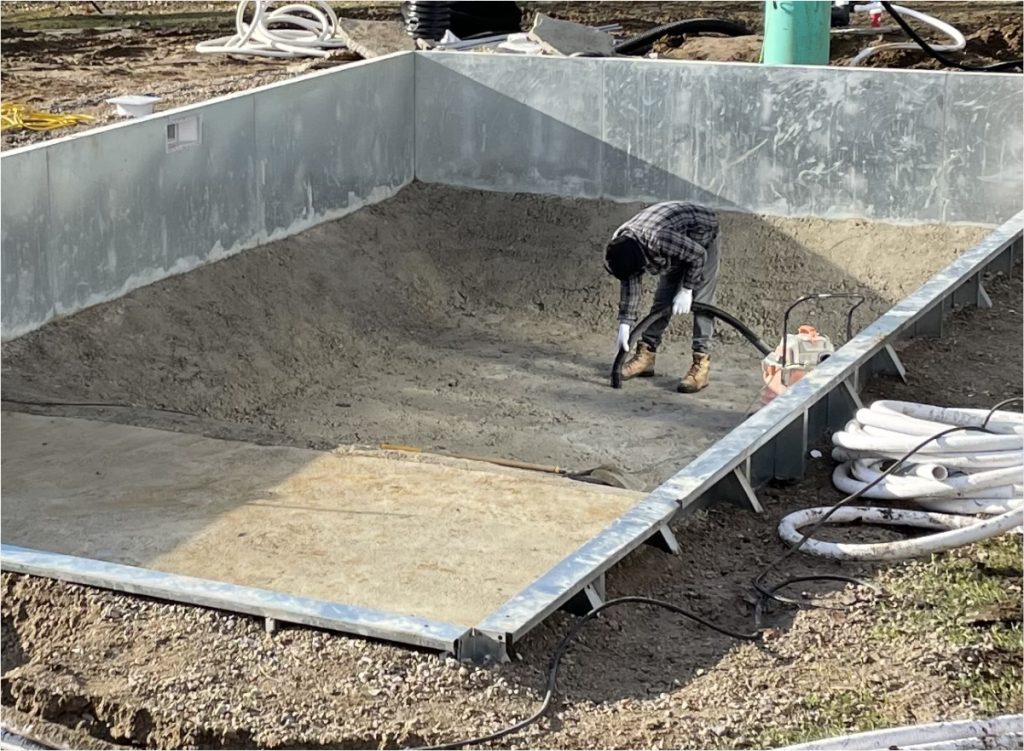Swimming pool concrete plays an important role in the construction of both pool shells and pool decks. It provides durability, aesthetics, and functionality. Whether you want to build a new pool or need to renovate an existing one, the application of concrete in pools must be explained.
Swimming pool concrete must meet the specific requirements of a pool’s environment, including structural integrity, chemical resistance, and adaptability to various designs. It needs to be strong enough to hold large amounts of water and withstand the chemicals used for pool maintenance.
Benefits of Using Concrete in Pool Shells
Durability & Customization
Concrete pool shells, somnetimes lined in vinyl, offer unique benefits compared to fibreglass pools including durability and ability to customize. Unlike pre-moulded fibreglass swimming pools, concrete pools can be tailored to fit any shape or size. The ability to customize allows for unique designs and helps create pools that match specific landscaping or architectural styles.
The solid nature of a concrete pool shell ensures longevity and minimal susceptibility to damage. Additionally, concrete’s adaptability makes it possible to incorporate various features such as tanning ledges, steps, and benches into the pool design. Together, these benefits make concrete a preferred choice for constructing durable, long-lasting pool shells.
Techniques for Applying Concrete to Pool Shells
Pool builders may spray concrete with either gunite or shotcrete application. Or they may build a framed structure and pour concrete into the mould. Concrete also makes an excellent reinforcement before lining the pool walls and floor with vinyl. Each method of pool construction offers distinct benefits.
Gunite

To apply gunite, a skilled pool contractor sprays a dry mix of cement and sand at high speed through a hose. It mixes with water at the nozzle as it sprays onto the pool’s steel framework. This technique results in a desnse and solid strcture. It also allows for excellent control over the application process, making it easier to form complex shapes and features within the pool shell.
Shotcrete

Similarly, shotcrete uses a pre-mixed wet slurry which includes an aggregate of small stones and gravel in additon to the cement and sand. Pool contractors also spray this mixture at high pressure onto a rebar framework. This method can result in a denser, more uniform concrete application with enhanced stength and stability. Both spray concrete methods allows for complete customization.
Poured

Alternatively, poured concrete can be used with a form or mould, or to reinforce a pool frame before you attach a vinyl liner. The method still offers some customization but takes significantly less time to build than a traditional concrete pool with gunite or shotcrete. After pouring the concrete into the pool frame, it must be trowelled smooth, similar to how you finish the pool deck or patios.
Preparing the Groundwork for a Concrete Pool Shell
Preparing the groundwork for a concrete pool shell involves meticulous planning and execution to ensure structural integrity. First, you excavate the pool area to the specified dimensions and depth. Next, you install a rebar framework which serves as the skeletal structure for the pool shell. This provides essential support and reinforcement.
To avoid cracks or shifting, proper drainage systems must be incorporated. This manages groundwater and prevents issues like water pressure buildup. Finally, the soil around the pool should be compacted and stabilized to avoid settling over time. Correctly implementing these elements can prevent costly repairs and extend the lifespan of the pool.
Learn More About the Process of Pool Construction With Vinyl On a Concrete Floor
Role of Concrete in Pool Deck Construction
Concrete also serves as an excellent material for pool decks due to its durability and versatility. It can withstand heavy foot traffic, exposure to water, and varying weather conditions, making it ideal for outdoor environments. Depending on the finish, concrete decks may also offer excellent slip resistance, enhancing safety around the pool area.
Various finishes, such as stamped or brushed concrete, can add aesthetic appeal while maintaining functionality. The ability to colour or texture concrete allows for creative designs that can complement the pool and surrounding landscape.
Additionally, concrete’s low maintenance requirements make it a practical choice for busy homeowners. The combination of strength, safety, and design flexibility makes concrete an optimal material for pool decks.
Maintenance Tips for Concrete Pool Shells and Decks
To keep your swimming pool concrete in top condition, you must maintain it regularly.
Consistent Cleaning
Remove debris like leaves and dirt from the pool and deck surfaces to prevent staining and clogging of drainage systems. Use a pool vacuum for the shell and a broom or pressure washer for the deck.
Concrete Sealing
Sealing concrete surfaces every few years adds a protective layer that guards against water penetration and chemical damage. Opt for a high-quality, weather-resistant sealer to prolong the life of your concrete.
Monitor Water Chemistry
Imbalanced water can deteriorate the concrete and vinyl liner causing surface etching or discoloration. Test the water regularly for pH, alkalinity, and calcium hardness, then adjust to maintain optimal levels.
Repair Minor Cracks or Chips
Address them promptly using appropriate repair materials like hydraulic cement or epoxy fillers. Ignoring small issues can lead to more extensive damage over time, requiring costly repairs.
Resurface Spalling and Peeling
If your pool deck shows signs of wear, consider resurfacing it with a decorative concrete overlay to restore its appearance and functionality. This can also prevent further damage.
Maintain Drainage Systems
Ensure all components of your drainage system function correctly to prevent water accumulation that could compromise the integrity of the concrete.
Taking these proactive steps will help maintain the durability and aesthetic appeal of your concrete pool shells and decks for years to come.
Conclusion
Swimming pool concrete offers unmatched durability and customization options for both pool shells and decks. Its ability to be moulded into various shapes and sizes makes it ideal for creating unique pool designs that cater to individual tastes and specific landscaping requirements.
Concrete pools also provide the strength needed to withstand daily wear and tear, as well as exposure to chemicals and weather conditions. Proper maintenance, including regular cleaning and water chemistry management, is essential to preserving the longevity and appearance of concrete structures.
Additionally, the various finishing options for concrete decks, such as stamped or coloured concrete, allow for a personalized aesthetic that enhances the overall pool area. Understanding these benefits helps homeowners and contractors make informed choices, ensuring a beautiful and long-lasting pool environment.



